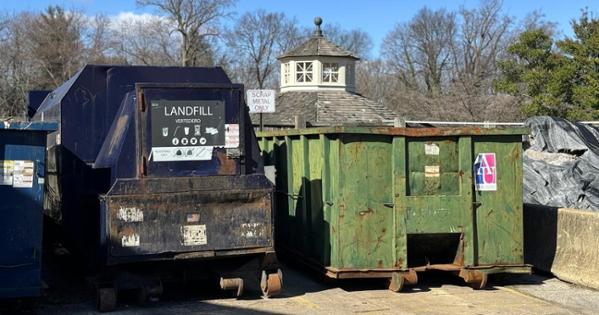Trace Your Waste

Dumped in a campus compost bin, the dregs of your burrito bowl reach the first stop in their journey back to nature.
As part of the Office of Sustainability’s Sustainabili-Tea Series, Facilities Management led a tour on February 14, explaining how to sort waste on campus and where it ends up once tossed. There’s no better time for Eagles to freshen up on the topic with the Campus Race to Zero Waste in full swing. The competition, which runs through March 23, challenges participating colleges and universities to divert as much from landfills as possible.
While AU prides itself on being sustainability-forward, there is still room for improvement—especially as waste sorting is concerned. According to sustainability manager Anna Parse Johnson, CAS/BS ’19, AU achieved a 5 percent compost rate and 10 percent recycling rate during the second week of the competition, February 4–10. The remaining 85 percent of waste ended up in the landfill.
“A lot of times when people come to AU, they think that we do so well with sustainability that it doesn’t really matter what happens with their waste or if [they]’re turning lights off in classrooms,” said Parse Johnson. But “all of those small things add up.”
So, how can you help? Review AU’s waste-sorting guidelines and swap single-use plastics for reusables, she said.
Achieving zero waste—the university’s goal by 2030—will take time and effort, said Caroline Boone, zero waste manager, who led the tour alongside recycling specialist Joe Boudah, SIS/BA ’19. Boudah invited staff to request sorting workshops for their offices and event planners to ask about waste signage and food recovery. The idea is to break down barriers to action, Boone said, making it simple for Eagles to make green choices.
The three-bin setup is a staple around campus. Orange bins signal compost, blue recycling, and black landfill. “We found that clustering bins together helps reduce contamination,” Boudah said. If you’re eager to toss your trash, “I don’t want you to drop [it] in compost just because that’s the only [option] next to you,” he said. Another no-no is throwing a dirty or liquid-filled cup in recycling, a move that can contaminate the rest of a bag’s contents. The presence of three bins, with pictures of commonly deposited items on each, encourages Eagles to pick the proper dumping place.
On the lowest level of the Bender Library stairwell, Boudah and Boone pointed out even more resources. Dubbed Recyleland, the sustainability hub houses bins for batteries, plastic bags, cell phones, and ink cartridges.
“We put a lot of effort into making sure that we know where all of our waste is going,” Boudah said, describing how AU employs a hauler of their own to deliver waste directly to trusted facilities.
But before this hauling happens, 75 percent of campus waste filters over by the Osborn Building and AU’s Sports Center Annex. In addition to large containers for yard and green waste, construction debris, and scrap-metal recycling, two landfill compactors wait. A New Holland machine stands by, ready to compress their contents. Trash and recycling are then routed to a local waste-transfer station.
As for compost, bagsful that pass initial contamination checks are picked up, weighed, and sorted by student workers—then fed to a compactor outside Anderson and Centennial Halls. The thousands of pounds collected weekly are then lugged to an industrial composting facility in Prince George’s County, Maryland. Walking the aisles of Ace Hardware or Home Depot, you just might spot your earlier meal scraps recycled as Leafgro soil conditioner.
Parse Johnson spoke to the rise of compostables on campus and AU’s shift away from plastic dependence. “I think we’re going to get to zero waste by 2030,” they said—with one caveat. “We need everyone on campus to be sorting their waste.”
Though waste management can feel like a heavy subject, Boone doesn’t want hopelessness to weigh anyone down. “We’re moving in the correct direction,” she said.
